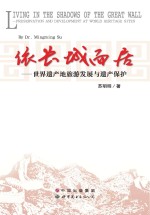

依长城而居 世界遗产地旅游发展与遗产保护PDF电子书下载
- 电子书积分:11 积分如何计算积分?
- 作 者:苏明明著
- 出 版 社:北京/西安:世界图书出版公司
- 出版年份:2013
- ISBN:9787510058813
- 页数:272 页
Chapter 1 Introduction 1
1.1 An overview 1
1.2 Research Goals and Research Questions 3
Chapter 2 Conceptual Context 4
2.1 Defining Heritage 4
2.1.1Definition of heritage 4
2.1.2 Chinese perspectives on heritage 6
2.1.3 Contestation of heritage 7
2.2 World Heritage Sites 11
2.2.1 Nomination of World Heritage Sites 12
2.2.2 Debate about the concept of World Heritage 13
2.2.3 Impacts of World Heritage on tourism 14
2.3 Relationships between Preservation and Tourism at World Heritage Sites 15
2.4 Important Considerations for Tourism and Preservation atWorld Heritage Sites 18
2.4.1 Stakeholder collaboration 18
2.4.2 Local community participation 19
2.4.3 Coordinating global and local relationships 26
2.5 Chinese Research on World Heritage tourism 28
2.5.1Importance of World Heritage tourism studies in China 28
2.5.2 Research on World Heritage tourism in China 29
2.5.3 Major concerns in tourism and preservation at World Heritage Sites in China 30
2.5.4 Areas to improve in World Heritage research in China 41
2.6 Chapter Summary 42
Chapter 3 The Context of World Heritage in China 44
3.1World Heritage Sites in China 44
3.1.1 World Heritage sites in Beijing 44
3.2 The Great Wall of China 45
3.2.1 Introduction to the Great Wall of China 45
3.2.2 The Great Wall of China as a World Heritage Site 46
3.3 Great Wall Sites in Beijing 49
3.3.1 Geographical features of Great Wall sites in Beijing 49
3.3.2 Tourism development status of Great Wall sites in Beijing 51
3.3.3 Questionnaire survey on Beijing residents 54
3.4 Study Site Selection 61
3.5 Chapter Summary 62
Chapter 4 Research Methodology 63
4.1Study Site 63
4.2 Data Collection Methods 64
4.2.1 Secondary data collection 65
4.2.2 Primary data collection 66
4.3 Methods of Data Analysis 75
4.4 Challenges and Limitations 76
4.5 Chapter Summary 77
Chapter 5 Badaling Great Wall 78
5.1 Badaling Great Wall and its neighborhood 78
5.2 Management structure 81
5.3 Heritage Protection 83
5.4 Tourism Development 85
5.5 Development Plans for Badaling Great Wall 87
5.6 Community participation 91
5.6.1 Small business operators 92
5.6.2 Site employees 101
5.6.3 Comparisons between small business operators and site employees 105
5.7 Chapter Summary 109
Chapter 6 Mutianyu Great Wall 113
6.1 Mutianyu Great Wall and Mutianyu Village 113
6.2 Management structure 114
6.3 Heritage Protection 117
6.4 Tourism Development 119
6.5 Development Plans for Mutianyu Great Wall 120
6.6 Community participation 121
6.6.1 International Residents in the Village 122
6.6.2 Small business operators 125
6.6.3 Mutianyu village residents 131
6.6.4 Site employees 135
6.6.5 Comparative discussion 139
6.7 Chapter Summary 142
Chapter 7 Comparison between Badaling and Mutianyu Great Wall 145
7.1 The Great Wall at Badaling and Mutianyu 145
7.2 Management Structure 146
7.3 Heritage Preservation 147
7.3.1 Current conditions of Great Wall at Badaling and Mutianyu 147
7.3.2 Funding resources 148
7.3.3 Impacts of World Heritage designation on Badaling and Mutianyu 149
7.4 Tourism Development 150
7.4.1 Transportation 150
7.4.2 On-site tourism facilities 150
7.4.3 Tourist numbers and capacities 152
7.4.4 Tourist behaviour 152
7.4.5 Tourism development 155
7.5 Plans for Development 160
7.5.1Important position in district development 160
7.5.2 The expansion trend 161
7.5.3 Collaboration within each Great Wall cluster 161
7.5.4 Local attitudes toward the plans 162
7.6 Local Participation in Heritage Tourism 163
7.6.1 Discussion about local participation 163
7.6.2 Analysis of local participation 166
7.7 Questionnaire Survey at Badaling and Mutianyu 169
7.7.1 Comparison of small tourism business 169
7.7.2 Comparison of opinions of small business operators 171
7.8 Chapter Summary 177
Chapter 8 Discussion 179
8.1Conceptual discussions 179
8.1.1Scales of heritage: global and local 179
8.1.2 Multiple uses of heritage 183
8.2 Empirical implications 186
8.2.1 Stakeholder collaboration in heritage management 186
8.2.2 Local participation in heritage tourism 188
8.2.3 Revisiting plans for their perspectives on the local communities 195
8.3 Chapter Summary 197
Chapter 9 Conclusions 198
9.1 Major Insights 198
9.2 Contributions 200
9.3 Future Research 203
9.4 Concluding Remark 205
Bibliography 207
Appendix Ⅰ 218
Appendix Ⅱ 227
Appendix Ⅲ 239
- 《红色旅游的社会效应研究》吴春焕著 2019
- 《近代旅游指南汇刊二编 16》王强主编 2017
- 《现代水泥技术发展与应用论文集》天津水泥工业设计研究院有限公司编 2019
- 《情报学 服务国家安全与发展的现代情报理论》赵冰峰著 2018
- 《学前儿童发展心理学 第2版》刘万伦主编;王文秀,甘卫群,刘万伦编写人员 2019
- 《中国制造业绿色供应链发展研究报告》中国电子信息产业发展研究院 2019
- 《中央财政支持提升专业服务产业发展能力项目水利工程专业课程建设成果 设施农业工程技术》赵英编 2018
- 《大学生心理健康与人生发展》王琳责任编辑;(中国)肖宇 2019
- 《大学英语教学的跨文化交际视角研究与创新发展》许丽云,刘枫,尚利明著 2020
- 《北京生态环境保护》《北京环境保护丛书》编委会编著 2018
- 《中风偏瘫 脑萎缩 痴呆 最新治疗原则与方法》孙作东著 2004
- 《水面舰艇编队作战运筹分析》谭安胜著 2009
- 《王蒙文集 新版 35 评点《红楼梦》 上》王蒙著 2020
- 《TED说话的力量 世界优秀演讲者的口才秘诀》(坦桑)阿卡什·P.卡里亚著 2019
- 《燕堂夜话》蒋忠和著 2019
- 《经久》静水边著 2019
- 《魔法销售台词》(美)埃尔默·惠勒著 2019
- 《微表情密码》(波)卡西亚·韦佐夫斯基,(波)帕特里克·韦佐夫斯基著 2019
- 《看书琐记与作文秘诀》鲁迅著 2019
- 《酒国》莫言著 2019
- 《TED说话的力量 世界优秀演讲者的口才秘诀》(坦桑)阿卡什·P.卡里亚著 2019
- 《小手画出大世界 恐龙世界》登亚编绘 2008
- 《近代世界史文献丛编 19》王强主编 2017
- 《课堂上听不到的历史传奇 世界政治军事名人 初中版》顾跃忠等编著 2015
- 《指向核心素养 北京十一学校名师教学设计 英语 七年级 上 配人教版》周志英总主编 2019
- 《365奇趣英语乐园 世界民间故事》爱思得图书国际企业 2018
- 《近代世界史文献丛编 36》王强主编 2017
- 《北京生态环境保护》《北京环境保护丛书》编委会编著 2018
- 《近代世界史文献丛编 11》王强主编 2017
- 《近代世界史文献丛编 18》王强主编 2017
